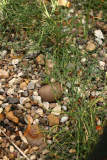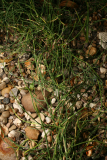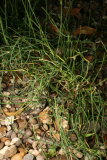Additional notes (click to expand)
Horticulture
The cultivation of Ephedra sinica in South Dakota
University of Florida https://ufdc.ufl.edu/AA00069513/00001/1x
The cultivation of Ephedra sinica in South Dakota
University of Florida https://ufdc.ufl.edu/AA00069513/00001/1x
Medicinal
Prescription only medicine: ephedrine, pseudephedrine, amphetamine, ecstasy
Induction of noradrenaline release. Contains ephedrine and pseudoephedrine. These are bronchial dilators and vasoconstrictors, used for asthma and nasal congestion. Amphetamines and ecstasy are synthesised from them.
Oakeley, Dr. H.F. (2013). Medicines from RCP plants label list 5-2013.docx.
Preparations of the whole herb, sold as Ephedra, often contain a mixture of species, not all of which contain the active alkaloids. Three Ephedra species -- Ephedra sinica, Ephedra equisetina, and Ephedra intermedia -- are collectively known by their Chinese name, ma huang. Ma huang has been used in Traditional Chinese Medicine (TCM) for more than 5,000 years, primarily to treat asthma or bronchitis.
Ephedra sinica. Ephedrine.
A tea made from these primitive plants has been used in China for more than 2000 years to aid sweating and to ease breathing in patients with chest infections. It was adopted in America and Europe in 19th and early 20th centuries to dilate the airways in asthma and to shrink the congested lining of the nose in colds by constricting small blood vessels. Ephedrine is still used to constrict blood vessels and control low blood pressure arising in epidural anaesthesia. There have been dangerous effects from the use of related drugs as a weight loss aid and to stimulate the brain. The active principal Ephedrine fires specific triggers on many types of cells by mimicking the actions of the sympathetic nervous system.
William Harvey and plant derived medicines currently used in cardiovascular medicine, Prof Michael de Swiet's Notes 2018
Nomenclature
Ephedra- Greek name for the common mare’s tail (Hippuris) which it somewhat resembles. For botanists, Ephedra is of great interest, as the genus forms a linking group between conifers and flowering plants.
Stearn, W.T. (1996). Dictionary of Plant Names for Gardeners. Cassell. p.132
Other use
A cyclist taking amphetamines (synthesised from ephedrine, present in the sap of the primitive plant species Ephedra) died in the 1960 games.
DeSwiet, Michael. (2012). Plants and the Olympic Games.
link
Toxicity
Toxic due to sympathomimetic actions. Deaths have been reported.
Professor Anthony Dayan, 2022
Geographical distribution
- Asia-Temperate, China
- Asia-Temperate, China, China North-Central
- Asia-Temperate, China, Inner Mongolia
- Asia-Temperate, China, Manchuria
- Asia-Temperate, Mongolia, Mongolia
- Asia-Temperate, Russian Far East, Primorye
- Asia-Temperate, Siberia, Buryatiya
- Asia-Temperate, Siberia, Chita
Ephedra sinica Stapf
Family: EPHEDRACEAEGenus: Ephedra
Species: sinica Stapf
Common names: Chinese Ephedra; Chinese Joint-fir
Distribution summary: China
Habit: Perennial
Hardiness: H5 - Hardy; cold winter
Habitat: Frequently on sandy soils
Garden status: Currently grown
Garden location: Arid zones (Q), Plants in pots (POT)
Flowering months: May, June
Reason for growing: Medicinal, toxic, prescription only medicine



.JPG)